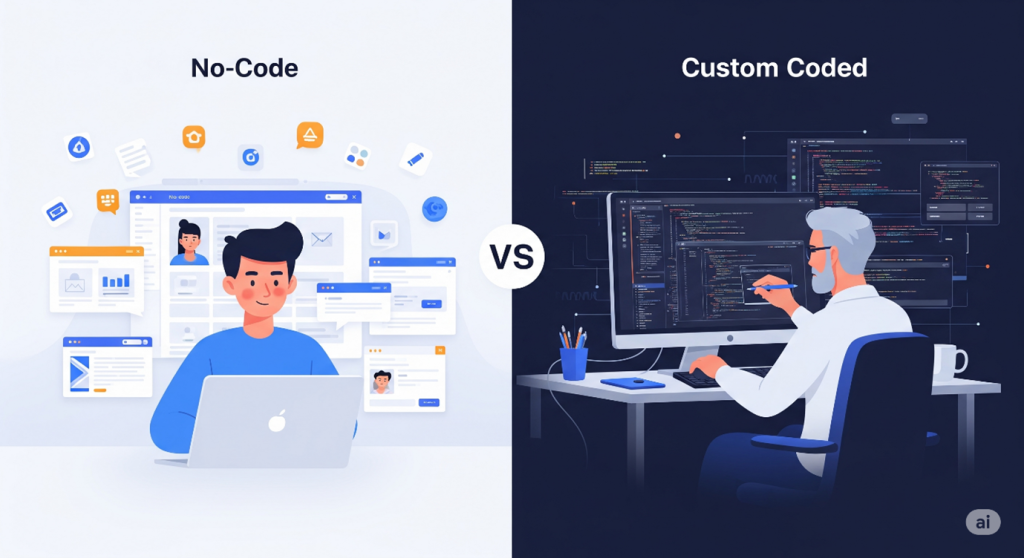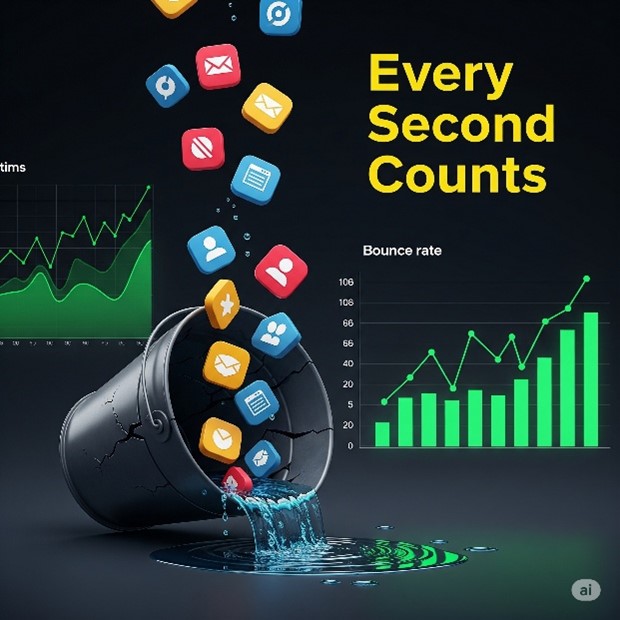Discover why no-code web design in 2025 can’t replace professional developers. Learn the hidden costs, limitations, and why custom coding delivers superior results for businesses.
Introduction
“No-code platforms will power 65% of all new websites by 2025.” Sounds impressive, right? Here’s what that statistic doesn’t reveal: most of those websites will fail spectacularly.
I’ve spent the last decade watching businesses chase the no-code dream. The promise is intoxicating build a professional website in hours, not weeks! Save thousands on development costs! Take control of your digital presence!
But then reality hits. Hard.
Your “professional” website looks identical to your competitor’s. Loading times crawl slower than dial-up internet. Customers bounce before your page even loads. Google buries your site on page 10 of search results.
The no-code revolution promised to level the playing field. Instead, it created a new problem: an internet flooded with mediocre websites that fail to convert visitors into customers. While these platforms serve specific purposes, the fundamental truth remains unchanged shortcuts in web design lead to long-term headaches.
Professional development isn’t just about writing code. It’s about strategy, performance, plus results that actually move your business forward. Let me show you why the smartest businesses still choose expertise over convenience!
What Is No-Code Web Design in 2025?
No-code web design lets you build websites without writing a single line of code. Think digital LEGO blocks you drag elements around, drop them into place, then hope they stick together properly.
These platforms evolved from clunky early tools into sophisticated visual builders. Popular platforms dominating the market include Webflow (the designer’s darling), Wix (the mass-market favorite), Squarespace (the aesthetic choice), Bubble (the app-builder), plus Framer (the newcomer).
These tools target entrepreneurs who want websites yesterday. Small business owners tired of developer costs. Non-technical founders who think they can DIY their way to digital success.
Template marketplaces overflow with thousands of designs. Every industry gets covered. Every style gets represented. Every business looks exactly the same.
But here’s what they don’t tell you those beautiful templates hide ugly limitations underneath.

The Seductive Appeal: Why Businesses Choose No-Code Solutions
The marketing pitch hits every pain point perfectly. “Build professional websites in minutes! Save thousands on development costs! No technical skills required!”
Cost comparison seems obvious: Professional website costs $1,000-$10,000. No-code subscription runs $20-$300 monthly. DIY time investment promises “just a few hours!”
Speed to market drives desperate decisions. Startups need MVPs yesterday. Marketing campaigns launch next week. Competitors already have websites while you’re still getting quotes.
The democratization promise feels empowering. Finally, non-technical founders can control their digital destiny! No more waiting for developers. No more confusing jargon. No more feeling helpless.
The Hidden Costs of No-Code Web Design
Free lunch doesn’t exist in web design. No-code platforms hide costs behind attractive monthly pricing.
Performance penalties hurt immediately. Average loading time hits 8+ seconds while professional sites load in 2-3 seconds. Bloated code makes browsers struggle. Unnecessary JavaScript libraries load on every page. Unoptimized images consume excessive bandwidth.
SEO limitations cripple your search visibility. Clean code matters for Google rankings. No-code platforms generate messy, inefficient markup that search engines hate.
Scalability roadblocks appear when success arrives. Traffic increases crash template-based sites. Database queries slow to crawls. Feature requests hit platform limitations.
Customization constraints frustrate growing businesses. You can’t modify core functionality. Integration options with business systems get limited. Payment processing capabilities stay restricted. User permission structures remain inflexible.
Vendor lock-in creates dangerous dependencies. Your entire web presence relies on one company’s platform. Price increases? You pay or lose everything. Platform shuts down? Your website disappears.
The “cheap” solution becomes expensive quickly.
Template Trap: Why Your Website Looks Like Everyone Else’s
Brand differentiation matters more than ever in crowded digital markets. Your website should scream “this is us!” Instead, templates whisper “we’re just like everyone else.”
Popular templates get recycled thousands of times. That sleek restaurant design? Used by 50,000+ establishments. The professional services layout? Every consultant’s favorite choice.
Psychology of brand perception works against templates. Customers recognize overused designs instantly. Generic appearance suggests generic service quality. Professional credibility suffers with amateur-looking sites. Trust decreases when websites look mass-produced.
Competitive disadvantages compound over time. While you blend into template mediocrity, smart competitors invest in unique professional designs that stand out.
Performance Problems That Kill Conversions
Website speed directly impacts your bottom line. One-second delays reduce conversions by 7%. Three-second delays lose 40% of visitors. No-code sites average 8+ second loading times.
Technical analysis reveals systemic problems. Bloated CSS files load unnecessary styles. Uncompressed images consume excessive bandwidth. Multiple JavaScript libraries conflict with each other. Inefficient database queries slow page generation.
Loading speed comparisons show stark differences. Professional developers optimize every element. Image compression, code minification, server configuration all tuned for maximum performance.
Mobile responsiveness suffers on template-based sites. Designs look great on desktop screens but break on smartphones. With 60% of traffic coming from mobile devices, this becomes critical. Google Core Web Vitals scores reveal the truth. No-code sites consistently score “Poor” or “Needs Improvement.” Professional sites achieve “Good” ratings through careful optimization.
SEO Nightmares: Why No-Code Sites Struggle in Search
Search engine optimization determines your website’s visibility. Get it wrong, and potential customers never find you. No-code platforms make SEO success nearly impossible.
Technical SEO limitations cripple rankings. Messy HTML structure confuses search engines. Limited control over meta tags hurts optimization. Inflexible URL structures damage keyword targeting. Poor internal linking capabilities prevent page authority distribution.
Code cleanliness matters enormously for search rankings. Professional developers write semantic HTML that search engines love. No-code platforms generate bloated markup that confuses crawlers.
Schema markup and structured data help search engines understand your content. Most no-code platforms offer limited or no schema implementation capabilities.

The Professional Developer Advantage
Professional developers bring strategic thinking that templates can’t replicate. We understand user psychology, conversion optimization, plus business goals beyond just “making things look pretty.”
Strategic expertise includes user experience research, conversion funnel optimization, A/B testing implementation, plus performance monitoring protocols.
Custom code optimization delivers measurable results. Every line serves a purpose. No bloated frameworks, unnecessary libraries, or template baggage slowing performance.
Advanced security implementations protect your business plus customer data. Professional developers understand encryption, secure authentication, plus compliance requirements.
Future-proofing through flexible architecture design prevents costly rebuilds. Professional sites adapt and evolve as your business grows.
The investment in expertise pays dividends through superior results, better performance, plus scalable solutions that grow with your success.
When No-Code Makes Sense (The Few Valid Use Cases)
No-code tools serve specific, limited purposes effectively. The key is understanding when shortcuts work plus when they hurt your business.
Rapid prototyping and concept validation work well. Test business ideas before major investments. Create mockups for stakeholder feedback. Validate market demand with minimal resources.
Internal tools and employee-only applications suit no-code platforms. These don’t face public scrutiny, performance demands, or competitive pressures.
Simple landing pages for marketing campaigns can work adequately. Single-purpose pages with clear calls-to-action. Short-term promotional campaigns. Lead generation with basic form collection.
The common thread? Low stakes, simple requirements, plus temporary needs. When your business depends on your website, professional development becomes essential.
Conclusion
The no-code revolution promised to democratize web design, but it delivered something else entirely: a flood of mediocre websites that fail to convert visitors into customers. While these platforms serve specific niches, the gap between DIY solutions and professional development continues to widen!
Professional developers bring strategic thinking, performance optimization, and custom solutions that no template can match. We’ve seen the data: businesses that invest in quality development see 3x higher conversion rates and 40% better search rankings.
Your website isn’t just a digital brochure it’s your most powerful business asset. Don’t let shortcuts sabotage your success. The choice between no-code convenience and professional excellence will define your online presence for years to come.
Ready to build something that actually drives results? Let’s create a website that grows with your ambitions instead of limiting them.


